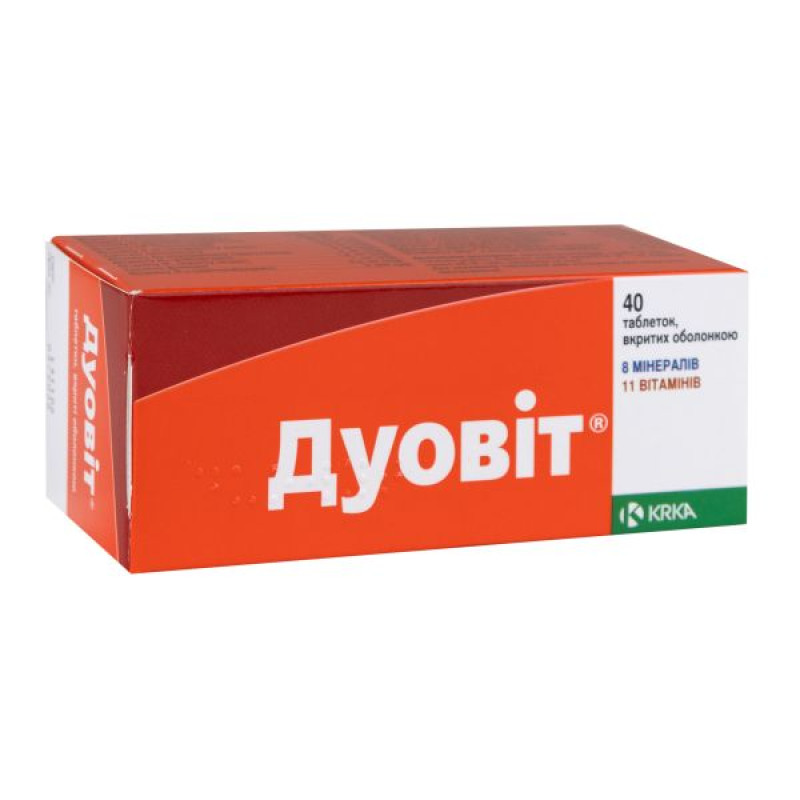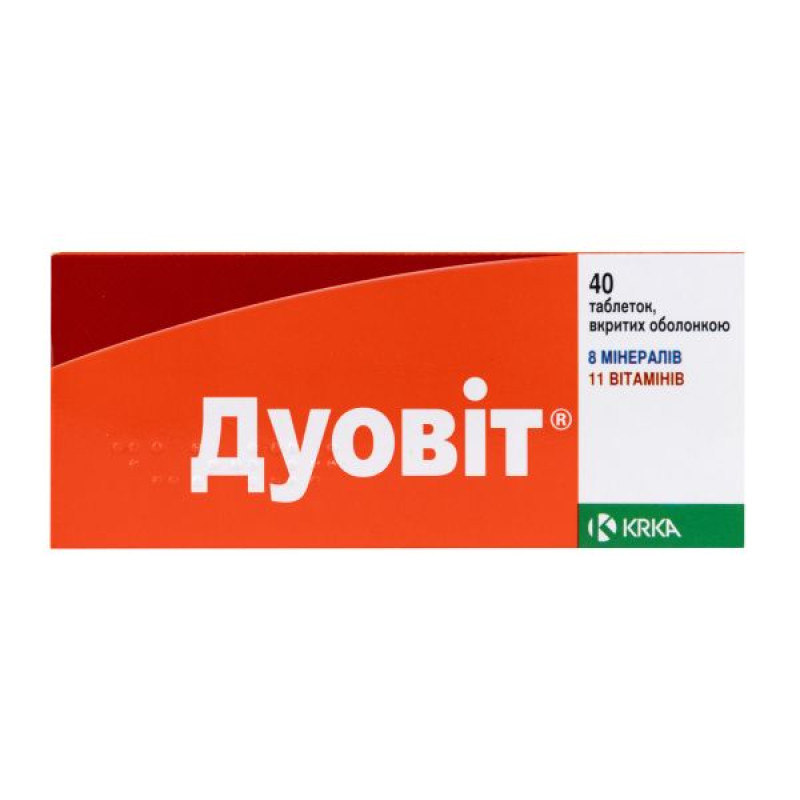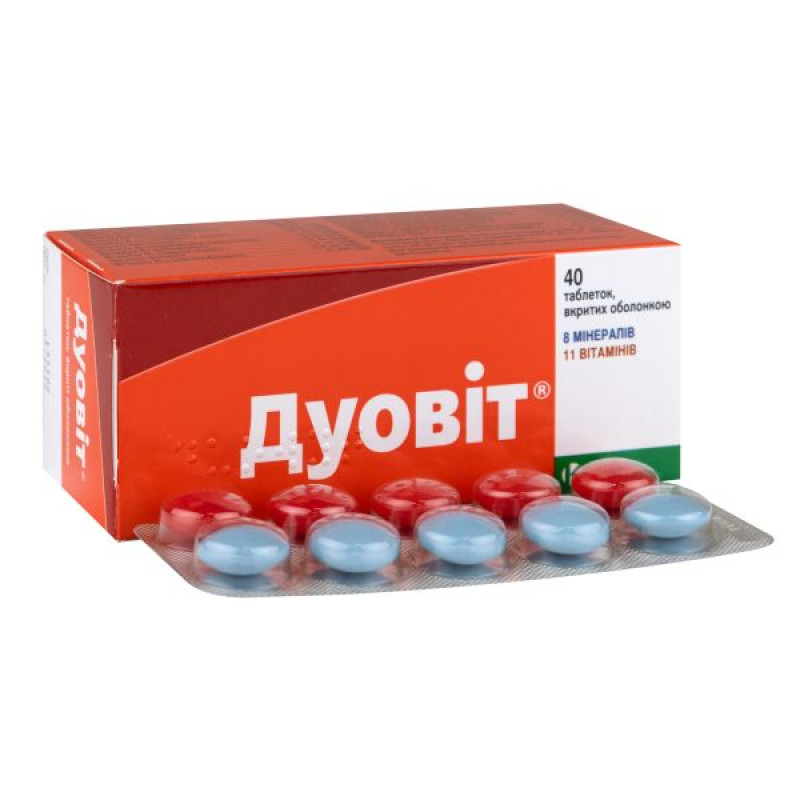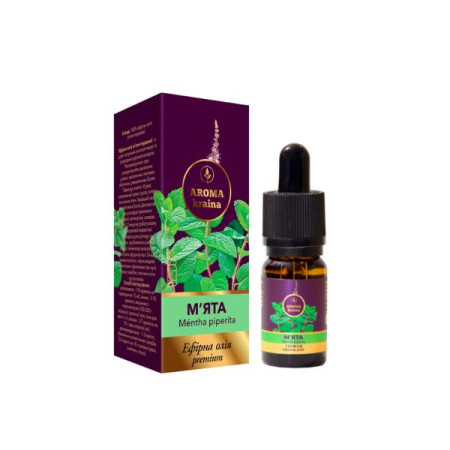Duovit film-coated tablets, combination pack No. 40

Instructions Duovit film-coated tablets combi-pack No. 40
Composition
active ingredients:
1 red film-coated tablet contains:
Vitamin A (retinol palmitate) 5000 IU; Vitamin D3 (cholecalciferol) 200 IU; Vitamin C (ascorbic acid) 60 mg; Vitamin PP (nicotinamide) 13 mg; Vitamin E (a-tocopherol acetate) 10 mg; Calcium pantothenate 5 mg; Vitamin B6 (pyridoxine hydrochloride) 2 mg; Vitamin B2 (riboflavin) 1.2 mg; Vitamin B1 (thiamine nitrate) 1 mg; Folic acid 0.4 mg; Vitamin B12 (cyanocobalamin) 3 mcg;
excipients: lactose monohydrate, orange oil flavoring, polysorbate 80, glycerin, castor oil, sorbitol (E 420), glucose solution, magnesium stearate, capol 600 pharma (contains yellow wax, carnauba wax, shellac), antifoaming agent, Opalux AS-F-2833G (contains sunset yellow FCF dye (E 110), povidone, sucrose, Ponceau 4R dye (E 124), titanium dioxide, sodium benzoate (E 211), purified water), sucrose, mannitol (E 421);
active ingredients:
1 blue film-coated tablet contains:
magnesium (Mg2+ as magnesium lactate) 20 mg; calcium (Ca2+ as calcium hydrogen phosphate) 15 mg; phosphorus (P5+ as calcium hydrogen phosphate) 12 mg; iron (Fe2+ as ferrous fumarate) 10 mg; zinc (Zn2+ as zinc sulfate) 3 mg; copper (Cu2+ as copper sulfate) 1 mg; manganese (Mn2+ as manganese sulfate) 1 mg; molybdenum (Mo6+ as sodium molybdate) 0.1 mg;
excipients: lactose monohydrate, orange oil flavoring, polysorbate 80, glycerin, castor oil, sorbitol (E 420), glucose solution, magnesium stearate, capol 600 pharma (contains yellow wax, carnauba wax, shellac), antifoaming agent, mineral oil, povidone, Opalux AS-20912 Blue (contains indigo carmine dye, povidone, sucrose, titanium dioxide, sodium benzoate (E 211), purified water), sucrose.
Dosage form
Film-coated tablets.
Main physicochemical properties: hard, smooth red tablets, coated with a shell, with a sweet and sour taste and possible inclusions on the surface; hard, smooth blue tablets, coated with a shell with possible inclusions on the surface.
Pharmacotherapeutic group
Multivitamins with trace elements. ATX code A11A A04.
Pharmacological properties
Pharmacodynamics
Duovit®, film-coated tablets, contain vitamins and trace elements. Vitamins and minerals are closely related in their functional activity and have an additive effect. Some vitamins and minerals cannot coexist, which is why they are separated into red (vitamins) and blue (minerals) Duovit® tablets.
B vitamins (B1, B2, B6, pantothenic acid and nicotinamide) are involved in the metabolism of carbohydrates, proteins and fats, and they also participate in the functioning of the nervous system. Vitamin B12 is involved in erythropoiesis, promotes the normal functioning of the nervous system. Vitamin A is needed for the development of epithelial cells and for the synthesis of visual pigment. Vitamin D3 regulates calcium absorption and promotes proper mineralization of bones and teeth. Vitamin C controls iron absorption and participates in many redox processes in the body. Vitamin E, a physiological antioxidant, protects cell membranes from damage and preserves their functionality.
Minerals and trace elements are extremely important for the body. They are components of tissues or activators and components of enzymes and hormones. Calcium and phosphorus play an important role in the mineralization of bones and teeth. Calcium ions activate many enzymes, participate in the regulation of heart muscle tone, in the transmission of nerve impulses and regulate the permeability of cell membranes. Iron and copper, together with B vitamins, are important for the formation of red blood cells. Magnesium, manganese, zinc and molybdenum play the role of enzyme components in many reactions important for the body.
Pharmacokinetics
There are no available data on the pharmacokinetics of Duovit® tablets. However, there is information in the scientific literature on the absorption, distribution and excretion of some vitamins and minerals.
Water-soluble vitamins (B vitamins, vitamin C) are absorbed within the daily requirements. Amounts exceeding the absorption by the tissues are excreted in the urine, and in some cases also in the feces. These vitamins are contained in the body in very small quantities, so their proper level in the body should be maintained.
After oral administration, the fat-soluble vitamins A and D3 are absorbed in the small intestine in the presence of fat. The absorption of vitamin E is relatively low (25% to 85% of the dose). These vitamins are stored in larger quantities in the liver and are therefore also more toxic than water-soluble vitamins.
Indication
Duovit®, film-coated tablets, are recommended for:
during physical and mental overload (during study, at work or at home); during active sports and active recreation; during impaired absorption of nutrients (during alcohol consumption, smoking, in the elderly); during inadequate and unbalanced nutrition; during dieting (weight loss and other types of diets); during periods of seasonal deficiency of fruits and vegetables in the diet; during significant loss of minerals (due to vomiting, diarrhea, excessive menstruation, increased sweating).
Contraindication
Hypersensitivity to the components of the drug, hypervitaminosis of vitamins A, E and D3, renal failure, severe renal dysfunction. Simultaneous use of retinoids. Nephrolithiasis, gout, hyperuricemia, erythremia, erythrocytosis, thrombophlebitis, thromboembolism, fructose intolerance, glucose-galactose malabsorption syndrome, iron or copper metabolism disorders, hypercalcemia, hypercalciuria, hypermagnesemia, thyrotoxicosis, chronic glomerulonephritis, chronic heart failure, sarcoidosis in history, gastric and duodenal ulcer in the acute stage (due to a possible increase in the acidity of gastric juice), active forms of tuberculosis.
Do not use in children (under 18 years of age).
Interaction with other medicinal products and other types of interactions
It is recommended to take the medicine 2 hours before or 2 hours after taking other medicines.
It is not recommended to use the drug together with drugs containing aromatic rings (tetracycline, quinolines, cholestyramine) and antacids.
The absorption of iron and calcium minerals, tetracycline and fluoroquinolone antibiotics is reduced when used simultaneously.
Some antacids containing aluminum, magnesium, or calcium reduce the absorption of minerals (iron).
Cholestyramine reduces iron absorption. Calcium may interfere with the absorption of levothyroxine. If concomitant administration of such drugs is necessary for treatment, the interval between administration should be 2 hours before taking Duovit® and 4–6 hours after taking it. Some products (for example, those containing oxalic acid, phosphates or phytic acid) may reduce calcium absorption.
Vitamin A and E mutually enhance the effect and are synergists. Due to the possible occurrence of vitamin A hypervitaminosis, the simultaneous use of Duovit®, film-coated tablets, with other drugs containing vitamin A or oral retinoids is not recommended. The use of vitamin E should be avoided in patients taking oral anticoagulants such as dicoumarin, neodicoumarin, due to an increased tendency to bleeding. Vitamin E should not be used together with drugs containing large amounts of iron and silver due to their inhibitory effect on the vitamin. Alpha-tocopherol acetate enhances the effect of steroidal and non-steroidal anti-inflammatory drugs (diclofenac sodium, ibuprofen, prednisolone).
The risk of hypercalcemia increases with the simultaneous use of vitamin D3 and thiazide diuretics. Ion exchange resins such as cholestyramine and laxatives (paraffin oil) may reduce the absorption of vitamin D3. Due to metabolic activation, the activity of vitamin D3 may be reduced when used simultaneously with phenytoin or barbiturates. Since the oral combination of calcium and vitamin D3 enhances the effect of cardiac glycosides, medical supervision and electrocardiogram monitoring are necessary during their simultaneous use.
During sulfonamide therapy to prevent crystalluria, large amounts of vitamin C should be avoided. Vitamin C slows down the absorption of beta-blockers and indirect anticoagulants. Simultaneous use of vitamin C and deferoxamine increases tissue toxicity of iron, especially in the heart muscle, which can lead to decompensation of the circulatory system. Vitamin C can be used only 2 hours after the injection of deferoxamine. Long-term use of large doses of ascorbic acid (more than 1 g) by persons treated with disulfiram inhibits the "disulfiram-alcohol" reaction. Calcium chloride, salicylates, corticosteroids, with prolonged use, reduce the reserves of ascorbic acid in the body. Absorption of ascorbic acid is reduced with simultaneous use of oral contraceptives, consumption of fruit or vegetable juices, alkaline drinks. Vitamin B1 can affect the action of curare drugs. Vitamin B2 reduces the absorption and effectiveness of antibiotics (streptomycin, doxycycline). It should be taken at least 3 hours before or 3 hours after a dose of the antibiotic. Tricyclic antidepressants may reduce riboflavin levels.
Vitamin B6 weakens the effect of levodopa if the patient takes only levodopa. Pyridoxine prevents or reduces toxic manifestations observed with the use of isoniazid and other anti-tuberculosis drugs.
H2 receptor antagonists, potassium supplements, alcohol (especially with prolonged use), and para-aminosalicylic acid (PASA) reduce the absorption of vitamin B12.
Folic acid reduces plasma concentrations of phenytoin; with other antiepileptic drugs, a mutual decrease in clinical efficacy is possible.
Application features
Duovit® tablets should be taken after a meal in the morning, otherwise they may cause stomach discomfort.
Patients with diabetes can use Duovit®, but they should take into account that the daily dose contains 1.6 g of sugar. Each film-coated tablet contains 0.8 g of sugar.
Women who have taken large doses of retinol (over 10,000 IU) should not plan pregnancy until 6–12 months after taking it. This is because during this time there is a risk of fetal development disorders due to the high content of vitamin A in the body.
The urine may turn yellow, which is a completely harmless factor and is explained by the presence of riboflavin in the drug.
The drug is not recommended to be prescribed together with other multivitamins, as an overdose of the latter in the body is possible.
Absorption of ascorbic acid may be impaired in intestinal dyskinesias, enteritis, and achilia. Since ascorbic acid increases iron absorption, its use in high doses may be dangerous for patients with hemochromatosis, thalassemia, polycythemia, leukemia, and sideroblastic anemia. Ascorbic acid as a reducing agent may affect the results of laboratory tests, for example, when determining the content of glucose, bilirubin, transaminase activity, and lactate dehydrogenase.
Special precautions for inactive ingredients
Duovit® contains lactose, sorbitol, glucose and sucrose. Patients with rare hereditary forms of fructose or galactose intolerance, the Lapp lactase deficiency or glucose-galactose malabsorption should not take this medicine.
Azo dyes E 124 and E 110 may cause allergic reactions.
Ability to influence reaction speed when driving vehicles or other mechanisms
There have been no reports of the drug affecting the ability to drive or operate other mechanical devices.
Use during pregnancy or breastfeeding
Since safety studies of the drug during pregnancy and breastfeeding have not been conducted, it should not be used in this category of patients. Animal studies have shown that vitamin A in high doses (100-1000 times the recommended daily dose for humans) has a teratogenic effect.
Method of administration and doses
Take 1 red vitamin tablet and 1 blue mineral tablet once a day.
The tablets should be swallowed whole after breakfast, with liquid.
Children
Do not use on children.
Overdose
At the recommended dosage, no intoxication is expected. The probability of overdose is minimal. In case of overdose, the manifestations of the listed adverse reactions increase, bloating (flatulence) may occur.
Prolonged use of high doses can cause hypervitaminosis A and D3. Overdose of vitamin D3 causes weakness, anorexia, nausea, vomiting, diarrhea, weight loss, fever, convulsions, disorders of the cardiovascular system and kidneys. Hypercalcemia may develop due to hypersensitivity to vitamin D3. Symptoms of hypercalcemia are anorexia, polyuria, nausea, vomiting, general weakness, headache, apathy, thirst.
Overdose of vitamin A can lead to headache, dizziness, sleep disturbances, nausea, vomiting, drowsiness, photophobia and convulsions. If the above symptoms appear, you should stop taking the drug and consult a doctor immediately. When using very large doses of vitamin E, headache, fatigue, nausea, diplopia, muscle weakness, mild creatinineuria and gastrointestinal disorders may occur.
Iron overdose may cause nausea, vomiting, diarrhea, abdominal pain, hematemesis, rectal bleeding, lethargy, acute vascular insufficiency. Hyperglycemia and acidosis may occur. Large doses of calcium may lead to constipation and the formation of urinary stones.
With prolonged use of ascorbic acid in high doses, inhibition of the function of the insular apparatus of the pancreas is possible, therefore it is necessary to monitor its functional capacity. Overdose can lead to changes in the renal excretion of ascorbic and uric acids during urine acetylation with the risk of oxalate stone formation. The use of large doses of ascorbic acid can lead to heartburn. If the recommended doses are significantly exceeded (the dose of vitamin C exceeds 1 g per day), renal failure, sleep disturbances, feeling of heat, increased fatigue, zinc and copper metabolism disorders, increased excitability, erythrocytopenia, neutrophilic leukocytosis are possible.
In case of overdose, Duovit® should be discontinued. If necessary, treatment should be initiated. Vomiting should be induced and large amounts of fluid should be administered.
If hypercalcemia is detected, a diet with limited amounts of calcium and vitamin D3 should be followed. Further treatment is symptomatic.
Adverse reactions
Side effects that may occur during the use of Duovit® are classified by frequency:
very common: > 1/10, common: > 1/100, < 1/10, uncommon: > 1/1000, < 1/100, rare: > 1/10000, < 1/1000, very rare: < 10000, frequency unknown (cannot be estimated from the available data).
Within each frequency grouping, adverse reactions are presented in order of decreasing seriousness.
If you take Duovit® tablets as prescribed, they do not cause side effects.
On the part of the immune system:
frequency unknown: anaphylactic reactions, angioedema, bronchospasm.
If hypersensitivity reactions occur, treatment should be discontinued and a doctor should be consulted. In case of anaphylactic reactions, medical attention should be sought immediately.
From the side of metabolism and nutrition:
frequency unknown: hypercalcemia, calcinosis.
From the nervous system:
frequency unknown: headache, dizziness, drowsiness.
From the blood:
frequency unknown: decreased blood clotting.
On the part of the organs of vision:
frequency unknown: visual disturbances.
From the gastrointestinal tract:
Rare: dyspepsia, nausea, vomiting, stomach pain, belching, constipation, diarrhea, increased secretion of gastric juice.
Skin and subcutaneous tissue disorders:
very rare: skin rash, urticaria, itching, redness of the skin, eczema.
Kidney and bladder:
uncommon: urine discoloration;
frequency unknown: hypercalciuria, damage to the glomerular apparatus of the kidneys.
General violations:
frequency unknown: hyperthermia, increased excitability, increased sweating.
With prolonged use in high doses, the following side effects occur:
From the side of metabolism and nutrition:
frequency unknown: hyperuricemia, decreased glucose tolerance, hyperglycemia, impaired glycogen synthesis.
From the nervous system:
frequency unknown: paresthesia.
From the heart:
frequency unknown: cardiac arrhythmias, arterial hypertension, myocardial dystrophy.
On the blood side:
frequency unknown: thrombocytosis, hyperprothrombinemia, thrombosis.
The use of ascorbic acid in doses exceeding 1 g per day in patients with glucose-6-phosphate dehydrogenase deficiency may cause hemolysis of erythrocytes (hemolytic anemia).
From the gastrointestinal tract:
very rare: gastric disorders.
Skin and subcutaneous tissue disorders:
frequency unknown: dryness and cracks on the palms and soles, hair loss, seborrheic rashes.
Kidney and bladder:
frequency unknown: renal failure, crystalluria, formation of urate, cystine and/or oxalate stones.
Research results:
frequency unknown: transient increase in the activity of aspartate aminotransferase (AST), lactate dehydrogenase, alkaline phosphatase, changes in urine parameters, increased calcium levels in the blood and urine, hyperglycemia, glycosuria.
Expiration date
2 years.
Storage conditions
Store at a temperature not exceeding 25 °C in the original packaging to protect from light and moisture.
Keep out of reach of children.
Packaging
5 red and 5 blue tablets in a blister, 4 blisters in a cardboard box.
Vacation category
Without a prescription.
Producer
KRKA, dd, Novo mesto, Slovenia.
Location of the manufacturer and its business address
Smarjeska cesta 6, 8501 Novo mesto, Slovenia.
There are no reviews for this product.
There are no reviews for this product, be the first to leave your review.
No questions about this product, be the first and ask your question.


















